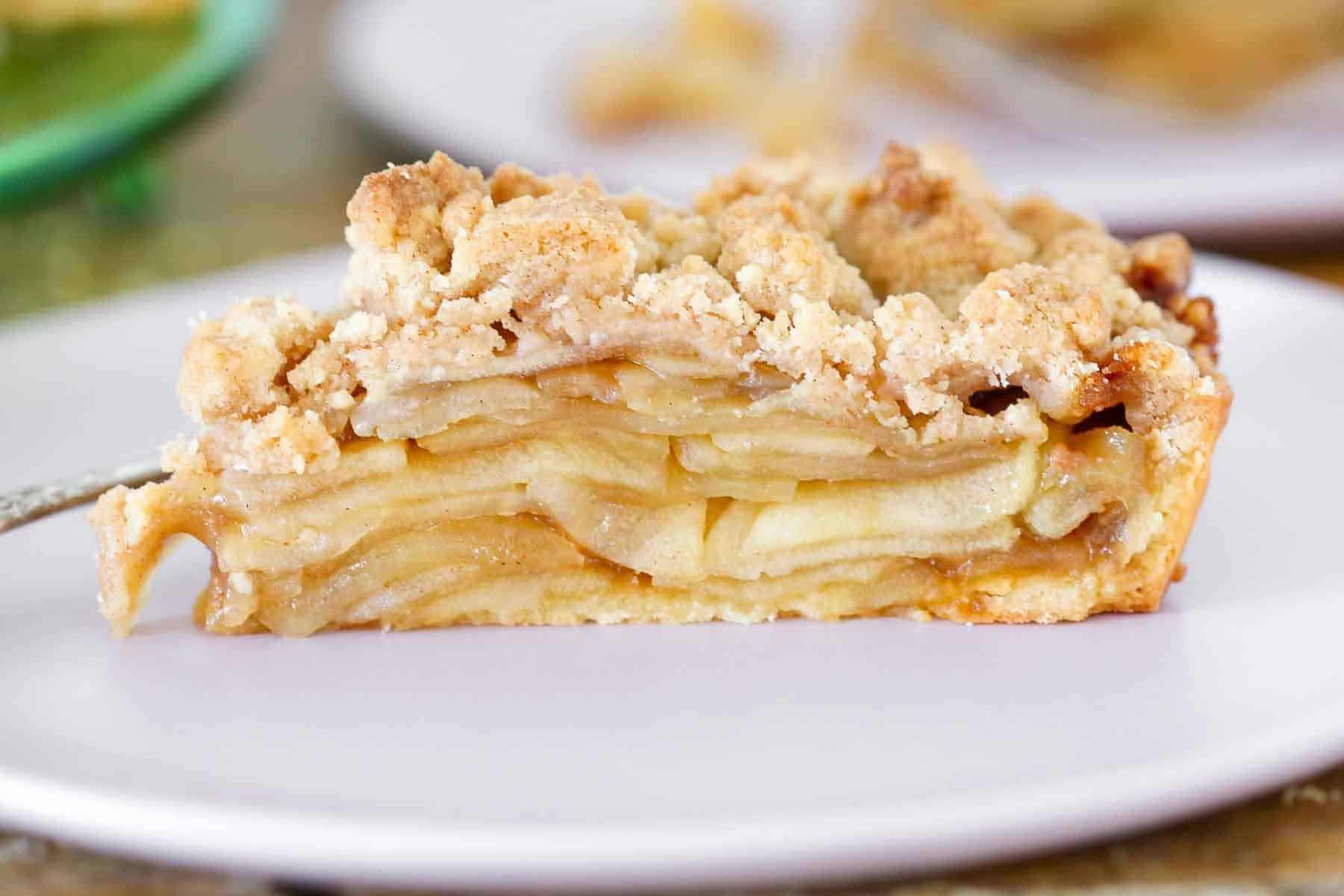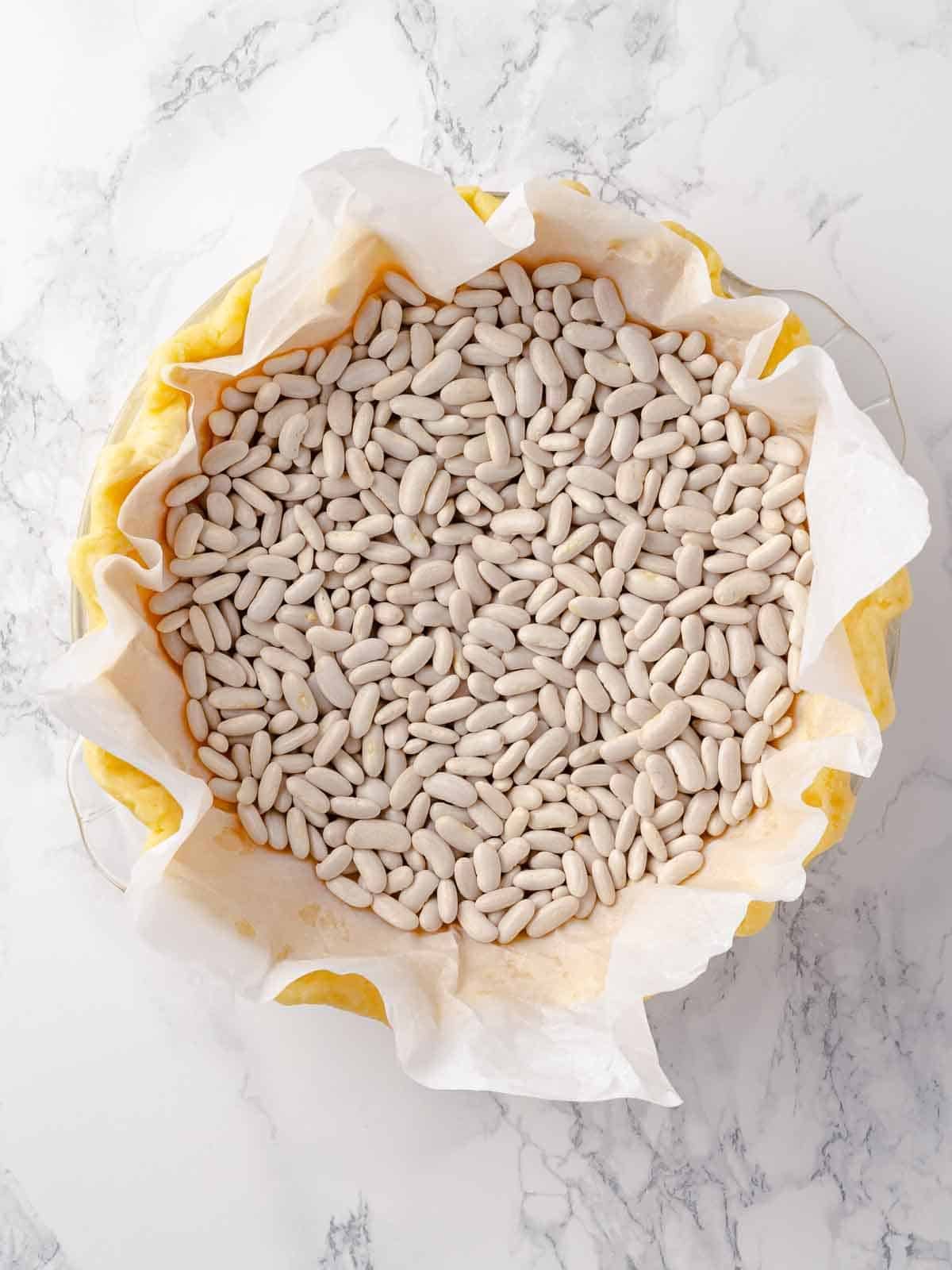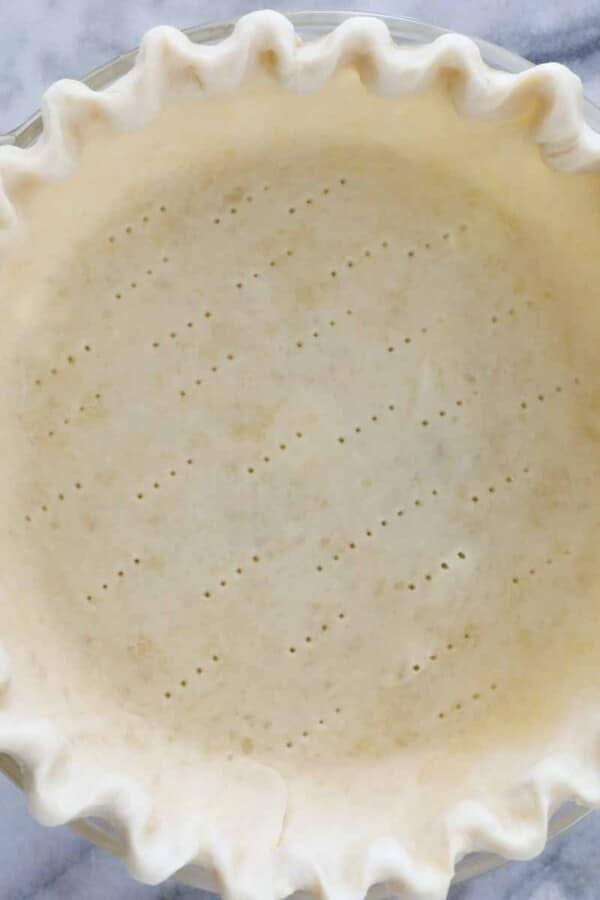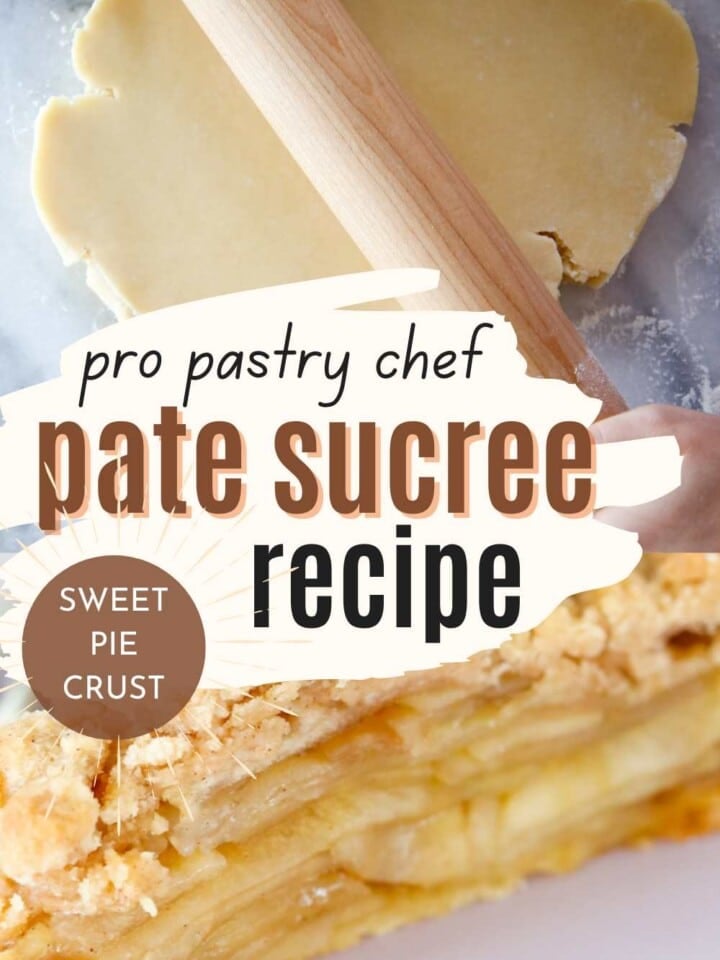This post may contain affiliate links. Please read our disclosure policy.
Pâte Sucrée is an easy sweet pie dough recipe that is buttery, rich and lightly sweetened. It only has 5 ingredients and is made like cookie dough! The perfect base for sweet tarts, pies, mini tartlets or individual pastries!

Pâte Sucrée is one of those essential pastry recipes that can even be used as a cookie in a pinch! Try it as a pie crust in a banana cream pie or lemon meringue pie, or fill it with almond cream, frangipane or hazelnut cream and fruit to make this cherry almond tart or hazelnut pear tart.
Pâte sucrée is French for “sweet pastry,” and can be use in the same way you would use an all-butter pie crust (pâte brisée), vodka pie crust, Crisco pie crust or even my almond tart crust. This is a pure pate sucree recipe, so it contains no almond flour. If you want that additional texture and flavor, try my almond tart crust or almond flour pie crust instead!
Table of Contents
Why This is the Best Pâte Sucrée Recipe
- Tender, delicate, and slightly sweet. This pro recipe produces a crust that is tender, crisp and delightfully sweetened.
- Mixed like a cookie dough!
- Versatile recipe for tarts, pies, tartlets and more! An easy to handle dough that is equally delicious in simple chocolate tarts filled with chocolate ganache as in elegant caramel apple tart!
- Time-tested recipe by a professional pastry chef. I used this easy sweet dough recipe countless times throughout my entire career in restaurants and bakeries!

Professional Tips for Making Pate Sucree
- Use room temperature butter & eggs. It is easier to cream in the powdered sugar and also to incorporate the dry ingredients if the butter is softened. Room temperature eggs will incorporate more easily into the dough. Cold eggs will harden the butter and make it almost impossible to emulsify.
- Sift the powdered sugar. I know, I know. The creaming method will not work out all lumps in the sugar, so sifting is the best practice.
- Mix just until a cohesive dough forms. Stay close to the mixer while the dry ingredients are incorporating. It will seem hopeless until suddenly a dough forms! Stop mixing or gluten will develop and you’ll get tough crusts.
- Roll between two pieces of parchment paper while the dough is room temperature. This will keep the dough from cracking and will still produce a tender crust as long as it is chilled thoroughly after rolling.
Ingredients & Substitutions
- Powdered Sugar
- Butter
- Large Eggs: I use whole eggs rather than just egg yolks in this recipe for the additional moisture. It helps the pastry dough come together.
- Pastry Flour or All-Purpose Flour: Either flour works in this recipe or you can use a low gluten all-purpose flour such as White Lilly.
- Kosher Salt: You can also omit the salt and use salted butter.
See the recipe card for full information on ingredients and quantities.

Possible Variations
- Add some spice: Add in cinnamon, apple pie spice, pumpkin spice, or even chai spice for a seasonal twist.
- Add some zest: Try zesting an orange or 2 lemons into the sugar prior to mixing for a citrus variation. Fill the pre-baked tart shell with pastry cream and fresh fruit for an easier twist on this puff pastry fruit tart!
- Add an extract: Add a teaspoon of vanilla extract along with the eggs, or try ½ teaspoon almond extract, orange or lemon extract, or even peppermint for a Holiday twist!
How to Make Pâte Sucrée
Use these instructions to make tender, professional pate sucree! Further details and measurements can be found in the recipe card below.
Step 1: Soften the butter in a stand mixer or let it sit out at room temperature for an hour or so.
Step 2: Put sifted powdered sugar and softened butter in stand mixer with the paddle attachment, and cream them (starting on low speed working up to medium-high speed, so the powdered sugar doesn’t fly everywhere). This will get silky smooth.
Step 3: Add the eggs one at a time on medium speed (it helps if the eggs are room temperature), it might look a little scary in the bowl, but don’t worry, the eggs will incorporate at their own pace.
Using softened butter and room temperature eggs that have been beaten does make this step easier.
Step 4: Add flour and salt to the bowl of the stand mixer and start mixer on low speed to cut the dry ingredients into the butter mixture, be patient and trust the process.
Step 5: Scrape the dough out of the mixer using a silicone spatula or bowl scraper. Divide it into the number of crusts you want, wrap them in plastic wrap and chill them for at least two hours.
I recommend rolling the dough out while still at room temperature between two pieces of parchment paper using a rolling pin. This is especially useful if making mini tarts or tiny pies. You can also freeze the dough at this stage. Cut out the desired size using a ring cutter, biscuit cutter, cookie cutter or trace around a pan using a paring knife.
How to Blind Bake Sweet Tart Crust
The process is generally the same one that I demonstrate with pie dough in my tutorial on how to blind bake pie crust, but this sweet tart dough is easier to work with, less likely to shrink and bakes faster than butter pastry!
Step 1: Preheat an oven to 325° F convection (with fan) or 350° F conventional (no fan).
Step 2: Line a pie plate with one of your chilled, rolled and cut crusts. Lift and crease to fit it snugly into the corners. If you are making a pie, roll the edges under into a tight spiral all the way around the edge. Either crimp, pinch or use a fork to create a decorative edge. If you are making a tart, use a rolling pin to cut the dough against the edges of the tart tin. This will make a perfect edge like you see in French pastry shops.
Step 2: Chill the dough in the tin for 30 minutes. Poke a few holes in the bottom of the crust if you are docking. See my tutorial on when to dock a pie crust for more details.
Step 3: Place a piece of parchment paper into the crust and fill with baking beans, rice or pie weights. Bake in preheated oven until the edges and bottom of the crust begin to brown.
Step 4: Remove the weights and continue baking until a light golden brown for partially baking or until a golden brown for fully blind baked.


Quick Answer: Partially bake a pie crust when you are going to continue baking the pie or tart like this bourbon chocolate pecan tart or sweet potato pie. Fully blind bake a pie crust or tart shell when you are going to fill it with an cold filling like French silk pie.
Chef Lindsey’s Recipe Tip
The dough is super forgiving. If you are lining a tart pan and you miss a spot, misjudge how large a circle you need, or it cracks, don’t stress. Just press another piece of dough over the crack or to fill in gaps.

Frequently Asked Questions
Store unbaked dough well wrapped in plastic wrap in the refrigerator for up to 3 days. This applies to dough pre and post rolling and to lined, unbaked pie or tart shells.
Store unbaked dough in the freezer for up to 2 months.
Baked tart or pie shells can be stored at room temperature for up to 3 days, refrigerated for up to 5 days, or frozen for up to 3 months.
Use this sweet pie dough in any sweet recipe. It is not the best choice for savory pies or tarts or free-form galettes. Do try it in my French silk pie, bourbon pecan tart, or this coconut mango tart. It is perfect for pre-baking in tart pans or pie tins because it will not shrink and bakes beautifully! Fill those sweet tart shells with lemon curd, caramel pastry cream, chocolate pudding or butterscotch pudding!
Both pâte sucrée and pâte sablée are enriched pastry doughs, but sucree typically contains more whole eggs and sugar than sablee. The other key difference is the mixing method. Pâte sucrée is mixed using the creaming method like a cookie dough, while pâte sablée is mixed using the cut-in method like a pie crust. The eggs are added after the flour in sablee but the eggs are added before the flour in sucree.
If you tried this recipe and loved it please leave a 🌟 star rating and let me know how it goes in the comments below. I love hearing from you; your comments make my day!


Pâte Sucrée
Ingredients
- ¾ cup powdered sugar
- ¾ cup unsalted butter softened
- 2 large eggs room temperature
- 2 ¾ cups pastry flour or all-purpose flour
- ½ teaspoon kosher salt
Instructions
- Soften the butter in a stand mixer or let it sit out at room temperature for an hour or so. It is important that it is softened.
- Put sifted powdered sugar and softened butter in stand mixer with the paddle attachment, and cream them (starting on low speed working up to medium-high speed, so the powdered sugar doesn’t fly everywhere). This will get silky smooth.
- Add the eggs one at a time (it helps if the eggs are room temperature), it might look a little scary in the bowl, but don’t worry, the eggs will incorporate at their own pace. Pre-beating the eggs does make this step easier.
- Add flour and salt to the bowl of the stand mixer and start mixer on low speed to cut the dry ingredients into the butter mixture, be patient and trust the process.
- Take you’re the dough out of the mixer using a silicone spatula or bowl scraper. Divide it into the number of crusts you want, wrap them in plastic wrap and chill them for at least two hours.
- I recommend rolling the dough out while still at room temperature between two pieces of parchment paper. This is especially useful if making tartlets or tiny pies. You can also freeze the dough at this stage.
Video
Notes
Nutrition
Before You Go
I hope you enjoyed this professional chef created recipe. Check out our other delicious pies and tart recipes like this mile high apple pie for more baking fun! Or peruse our dessert toppings and sauces to complete your dessert!
















Hi. I just wanted to point out that the ads on your recipe page cover some of the text, so it’s impossible to read the whole thing. Just a thought for your tech team.
Thank you,
Lidia
Hi Lidia! Thank you so much for letting me know, I really appreciate it. That definitely shouldn’t be happening. I’ll forward this to my tech team so they can take a look asap!
How man grams of dough do you use for each tart
Hi William! This recipe yields enough dough for 2, 8-9 inch tarts or pie crusts. So just take your total and divide by 2 if you’re going for those sizes! Happy baking!